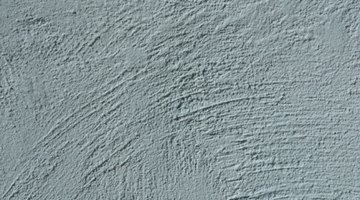How to Paint Textured Plaster Walls
Before manufactured drywall became widely available, interior walls were often constructed from lath and plaster. Home builders nailed small wood strips to framing studs, then smoothed plaster over the strips in multiple coats.

Because smoothing out plaster took considerable skill, you’ll find textured plaster mostly in homes built before World War II. The texture may vary, including shell and star patterns. If the wall is structurally sound, you can paint it.
Things You Will Need
- Masking tape
- Interior sealing primer
- Wall paint
- Large-nap paint roller
- Extension pole
- Paint pan
- Paint brushes
- Utility knife (or razor knife)
- Straightedge
Tip
Use latex caulk to fill small cracks in plaster before painting.
Warning
Wear old clothing when painting and cover existing floors to prevent spills and splatters.
-
Repair cracks and holes in plaster, if applicable, and remove nails, outlet covers and switch covers. Use masking tape to cover the electrical boxes beneath these covers to keep paint off.
-
Tape off baseboards, window trim and door trim with masking tape or with painter’s tape. When taping off, you’ll cover the adjacent edge of these items beneath the tape, but do not press the tape on too hard or it will be difficult to remove.
-
Roll a coat of interior sealing primer over the textured plaster wall. Use a large-nap roller and coat the entire wall with the primer. A sealing primer acts as a barrier, preventing rust and moisture stains from traveling through the plaster and showing up on the surface of your new paint.
-
Use a brush to paint the primer along the top edge of the wall and around the floor and trim work. Let the primer dry completely before painting.
-
Roll a coat of interior wall paint over the primer coat. Once again, use a large-nap roller because it holds more paint and the nap fits better into nooks and crannies in texture patterns.
-
Cut-in along the ceiling and trim work with a high-quality paint brush. The protective tape on the woodwork will keep stray paint off, but you can’t tape off the ceiling, so you’ll need a steady hand.
-
Let the first coat of paint dry completely, then cut in with a brush along the ceiling and walls again with a second coat, followed by a final rolling of paint over the wall’s surface. In the final coat, roll as closely as possible to the ceiling and the trim work without actually touching these items with the roller. This will help cover the strokes left behind by the brush.
-
Examine the wall for any crevices in the texture that the roller did not paint, and dab a little paint into those areas with the tip of your paintbrush.
-
Use a utility knife and a straightedge to cut along the taped woodwork before pulling the protective tape off.
The Drip Cap
- Before manufactured drywall became widely available, interior walls were often constructed from lath and plaster.
- Home builders nailed small wood strips to framing studs, then smoothed plaster over the strips in multiple coats.
- Repair cracks and holes in plaster, if applicable, and remove nails, outlet covers and switch covers.
- When taping off, you’ll cover the adjacent edge of these items beneath the tape, but do not press the tape on too hard or it will be difficult to remove.
- Use a large-nap roller and coat the entire wall with the primer.
Writer Bio
Glenda Taylor is a contractor and a full-time writer specializing in construction writing. She also enjoys writing business and finance, food and drink and pet-related articles. Her education includes marketing and a bachelor's degree in journalism from the University of Kansas.
Photo Credits
- Jupiterimages/Photos.com/Getty Images
- Jupiterimages/Photos.com/Getty Images
More Articles



